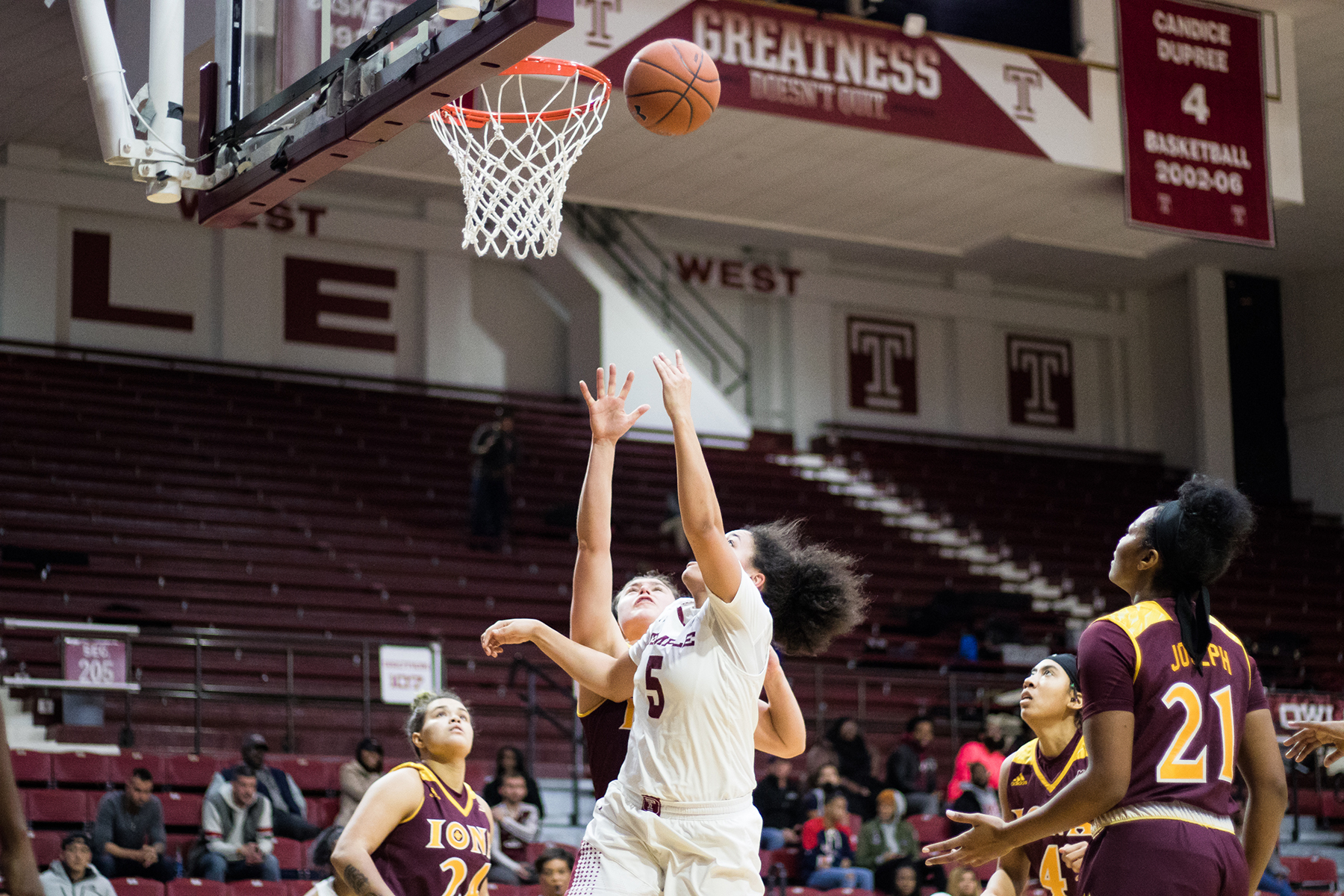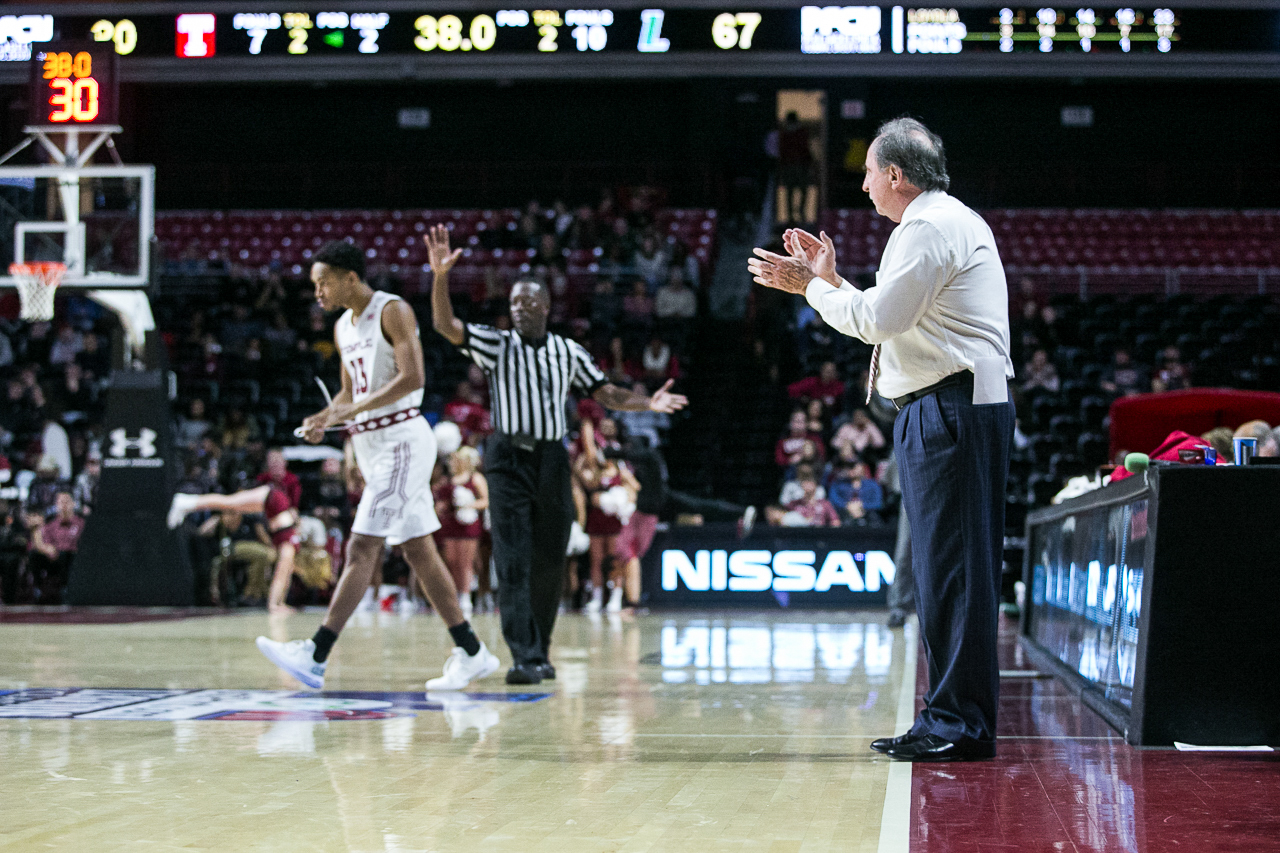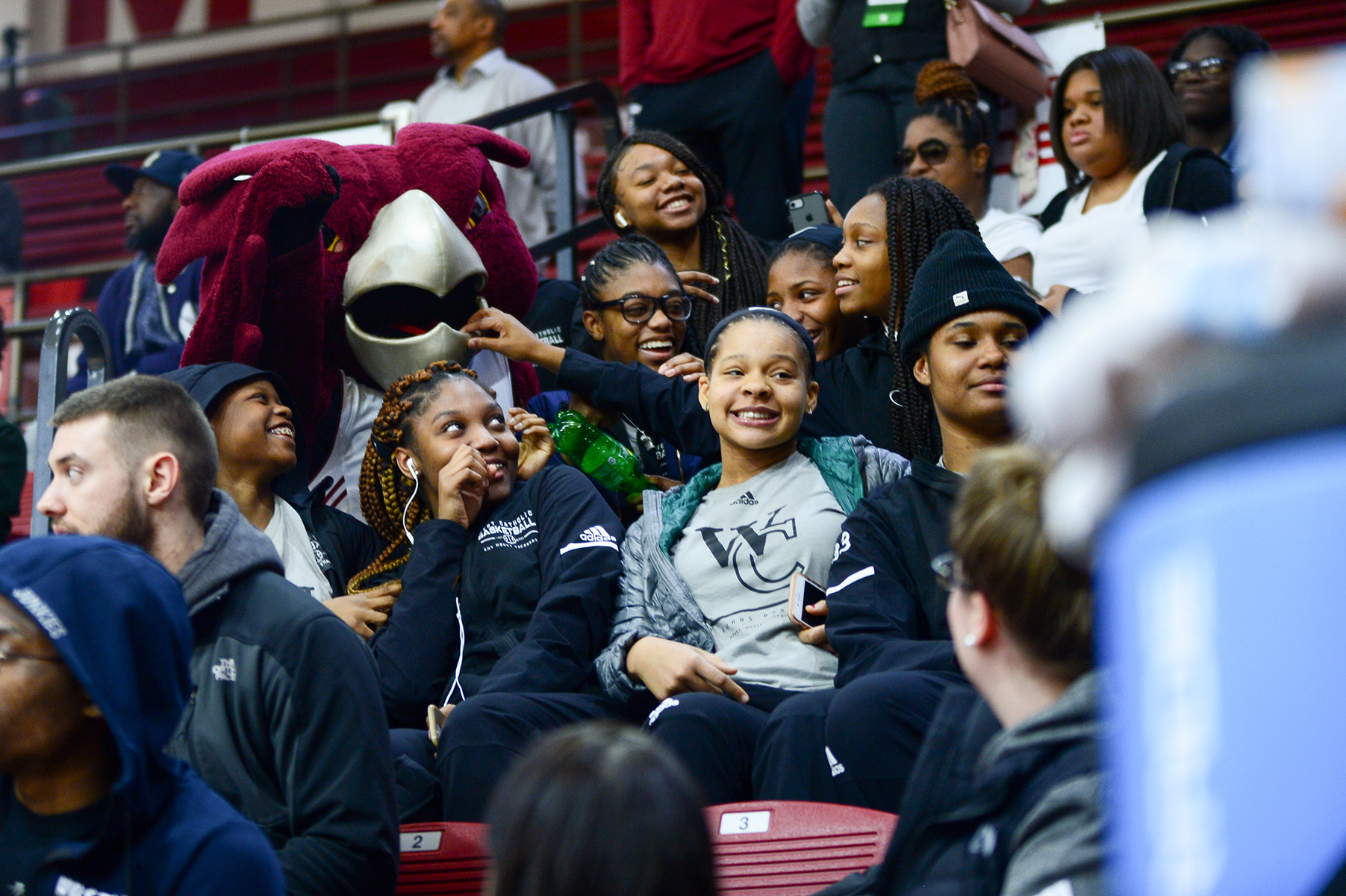Before the 2018 Temple University football season, players and fans rallied around the hashtag #FillTheLinc.
This slogan, along with other Temple Athletics strategies, is meant to involve students and alumni. But it’s more like a pipe dream for any of Temple’s ticketed sports — football and men’s and women’s basketball — to fill the venues in which they play.
The football team has only filled the Linc’s nearly 70,000 seats three times since it began playing there in 2003. For most games, thousands of empty seats intended for students are covered up by Temple “T” tarps at Lincoln Financial Field. Men’s basketball made the NCAA Tournament this year, but it averaged only 722 students at its home games, down more than 500 students from the 2015-16 tournament season. And during the past five seasons, women’s basketball attendance has remained stagnant at about 1,480 total fans per game.
The number of tickets sold at Temple football games has increased in the last few years, bucking national trends. But the football team, nor any other is able to fill its venue, or sometimes even fill it to half capacity. This leads students to pick up tickets, but never go into the game, or not even bother picking up tickets at all.
Temple and other universities face similar challenges in attracting students who are busy with classes, jobs and internships to attend athletic events. Not all of Temple’s more than 11,000 students who live on or near Main Campus are interested in sports. Those who are, plus the roughly 15 percent of Philadelphians with Temple degrees, can watch televised games in their rooms or at a bar.
Fighting for the spotlight
In 2015, a few years before the Eagles won the Super Bowl, the Owls were the talk of the town.
The Owls started 7-0, earned a top-25 ranking and hosted ESPN’s College Gameday. Temple faced off against Notre Dame on Oct. 31, 2015 — the last time the university sold out the Linc. At the time, the Owls were the only Philadelphia team worth noting, with the Eagles below .500 and the Flyers and Sixers just beginning their seasons.
Ten years prior, with Temple in the midst of an 0-11 season playing as an independent after being kicked out of the Big East Conference, that would have been unimaginable. For a long time, Temple was known nationally for its men’s basketball team and former coach John Chaney’s zone defense, not football.
During Temple’s five-year football attendance increase from 2013-17, the team recorded the highest average in 2015 at more than 44,000, aided by sellouts against Penn State and Notre Dame.
“The Linc is not too big when you play Notre Dame and Penn State,” said Craig Angelos, the deputy director of athletics. ”But when you’re playing East Carolina and someone like that, Memphis, then we’re just not getting those fans out. …But week in and week out, perhaps that is too big for sure.”
The athletic department has heard from students that they’re less likely to attend when the Owls face low-profile teams, like East Carolina in football, Iona College in women’s basketball and Loyola University Maryland in men’s basketball.

“Our goal and hope is, you know what, it shouldn’t matter who Temple is playing,” said Scott Walcoff, the senior associate athletic director for external operations. “Be there to support Temple. Don’t just come because we’re playing a big team. Come to see us play. Come to see your school play. That’s the mindset we’re trying to get everybody into. That’s the culture we’re trying to develop.”
Some students, who make the trek to South Philadelphia for football or walk right on campus to a basketball game, don’t want to come into the game.
For sophomore accounting major Greg Borgia, the atmosphere at the only football game he attended during his freshman year was “lacking” and “dead.”
“The atmosphere is not great,” Borgia said. “I usually go to the tailgates and leave, which is what everyone usually does. The one time I went into a game, the atmosphere was dead. I didn’t feel like I was at a college football game.”
One of the biggest competitors for students’ attention is the city itself.
Philadelphia has more than 1.5 million people. There are dozens of attractions like museums, theaters, restaurants and major professional sports teams that also vie for students’ attention.
“There’s so much going on simultaneously in the city and there no real start and end of campus,” said Eddie Madrid, a junior media studies and production major and transfer from Montgomery County Community College. “So really I feel some students, like myself, feel like the student body isn’t really all that together as compared to other schools.”
Impact on student-athletes and student life
During new student orientations, incoming freshmen learn Temple’s fight song. Every Friday is a “Cherry On Friday” when students are encouraged to wear the school’s signature color.
Yet about a dozen students said Temple’s student body has little to no school spirit.
“I used to have a Wild Cherry Pass, but I stopped because I did not have time and I was not fully invested,” said Leeannah McNew, a sophomore public relations major. “It’s hard to have school spirit because the general school population doesn’t.”
Whether it is not filling student sections, cheering during games or leaving games before they start, students like junior finance major Connor Dosenbach believe Temple’s student body can show more appreciation toward the university’s sports teams and athletes.
Sometimes, students and other fans do show up. But a poor team performance can deter them from coming back.
For example, an announced crowd of 32,357, the number of tickets sold, came to watch Temple’s football season opener against Villanova in September 2018.
After the Owls lost the game to its Football Championship Subdivision opponent, the announced crowd dropped to 25,511 against the University at Buffalo the next week. The number of students dropped from 3,845 to 2,230.
Four schools — the University of Miami, Pittsburgh, South Florida and Temple — played their home games in NFL stadiums in 2017. Miami had an 89 percent attendance average, but none of the other schools surpassed 60 percent.
Players like graduate student defensive end Zack Mesday know the Linc is not going to be filled all the time, but that won’t stop the players from trying, he said.
“There is always that group of people, nucleus of people, who always are going to be there, no matter who it is,” Mesday said. “They get on us, but they love us more than anyone else.”
Die-hard students will always come to games, and some students simply won’t be interested, Walcoff said. The focus is on getting those students in the middle of the spectrum into seats on game day, he added.
“It’s how do we get that group to take that next hurdle and go to the games, and that’s what we’re trying to figure out,” Walcoff said.
When students and fans aren’t showing up, that often means student-athletes have to look to one another for energy and school spirit, like for the men’s basketball matchup this year against the University of Detroit Mercy.

Athletes love to embrace crowds, especially student sections, at home games, senior guard Alani Moore II said. The difference in crowd sizes can affect how athletes approach games.
Women’s basketball players like junior center Shannen Atkinson and junior forward Shantay Taylor said the annual School Day game with hundreds of elementary school students in the Liacouras Center is the most fun home game of the year.
“It’s better to put on a show when you have a crowd than you don’t have a crowd and it’s like, you’re just playing,” Atkinson said. “But it’s definitely better to have a crowd that you can play for, have people cheer you on and stuff during the game.”

The 2019 women’s NCAA Tournament had its highest attendance in 15 years. But much like at Temple, Division I home attendance hasn’t changed much recently, increasing by just 43 people from the 2013-14 season to 2017-18.
“I always think there’s room for improvement, and I think a lot more people could come and support us and it would help us too as well play better and feed off their energy,” Taylor said.
Stadium: Is another on-campus venue the answer?
As Temple has improved its performance in football, it has pushed for a 35,000-seat on-campus stadium. One of its goals is to “manage the gameday experience to draw more students to games,” according to a 2018 project overview released by the university.
Angelos has worked at other schools, like the University of Miami and South Florida, which play off campus. Taking a bus to a game, even when free, doesn’t provide students flexibility and can be a deterrent, he said. The university hopes a smaller venue with a higher percentage of seats filled would create a more exciting atmosphere.
The projected $126 million stadium would require closing 15th Street between Norris and Montgomery Avenue and has received opposition from some students, North Philadelphia residents and the three most recent Temple Student Government administrations.
This facility would include retail space, classrooms and a concussion research center. Temple officials hope to host football games on campus for the first time in school history and save money spent on a lease agreement with the Eagles. For now, the project is “on hold” and Temple will need to approach the Eagles for another contract extension, university administrators told The Temple News in 2018.
Being in an NFL stadium that’s branded to the Eagles doesn’t allow for the feel of a true home game, said Chris Squeri, a 1996 sport management master’s alumnus.
An on-campus stadium can allow for that home-game feel, Squeri added. Fans could get “lost” in the Linc due to its sheer size. A smaller on-campus facility can create a closer atmosphere at games which will enhance the game-day experience for students and fans.
The athletic department has focused on in-game experience for fans. For example, the Liacouras Center used to offer students Club 1776, a space with video game consoles, free food and phone charging stations, but it got scrapped after being underutilized.
“If they want to just be able to sit in the comfort of their own home and have the refrigerator right there and not have to spend money to buy a ticket and drive down to Lincoln Financial Field or drive here to the Liacouras Center, a lot of teams fight that battle now,” Walcoff said. “So it’s again, what can we do to make their experience better to give them a reason to come down to the game.”
What students want
The athletic department surveyed students and found that giveaways are a big factor in getting them to attend games, said Karli Hausman, the assistant athletic director for marketing and fan engagement. One of the 2018-19 season’s most successful men’s basketball games, which brought in the third-highest student crowd, was the 90s Night T-shirt on Feb. 13.
The university might reintroduce a program it last tried about 10 years ago that offered rewards for attending a certain percentage of basketball games, Walcoff said. The athletic department decided to end the program because it didn’t boost attendance much and the same group of students mostly attended every game. Walcoff hopes it can be more successful with better prizes, he said.
Nationally, athletic departments are offering creative incentives to attract students. The University of Maryland used money from a donor to run a scholarship giveaway for students who entered before kickoff and stayed until the fourth quarter of football games. Student attendance increased 330 percent from its previous women’s basketball game after Kansas State University passed out free bacon at a game in 2013.
For some students, giveaways and promotions get them to a game, but they don’t keep them there.
“I’ll go to a basketball game if I’ve got nothing going that night and it’s a good game,” said Adam Hohner, a junior finance major. “There are times where I have gone to games just for a free T-shirt giveaway and have left before the game has started because the atmosphere is just lacking.”
Free food and other giveaways are the most appealing to her and other students, said Rachel Green, a junior tourism and hospitality management major. If the university increased the opportunity to get free food, more students might stick around, she added.
A better pre-game environment could increase student turnout, junior sports and recreation management major Ryan Noecker said. If Temple hosted game day tailgates for basketball and held pre-game activities on campus prior to events, more students, like himself, would be more inclined to go to a game.
The men’s basketball team would be open to the idea of being involved with pep rallies the day of games, Moore said.
“I think that would be a big help for us to get more fans and a bigger crowd,” Moore added. “Also, I think if we can interact with [student] more, that would be fun. They’ll get to know us a little better, you know just being able to connect with our fans.”
Even if a student sees a poster, advertisement or email and decides to head to the Linc, there isn’t a guarantee they’ll leave the parking lot. Some students would rather stay at the tailgate, leading to consideration of ways to “migrate that party into the stadium,” Hausman said.
At the end of the day, attendance is up to the person, with or without a giveaway.
“It’s really up to our students, alum and fans,” Squeri said. “The reason why we are not as big as Power Five schools is because our students, fans and alums, we don’t give enough money, and we don’t attend enough games. If we had 35-to-40,000 in the Linc every game and we had twice as many donors, we probably could be having a different conversation today.”
Words and reporting by Evan Easterling, Sam Neumann and Michael Zingrone.
Graphics and data analysis by Ian Walker.
Photos by Justin Oakes, Maggie Loesch, Geneva Heffernan and HoJun Yu.
Web Page produced by Julie Christie.
This article was first published May 2, 2019.